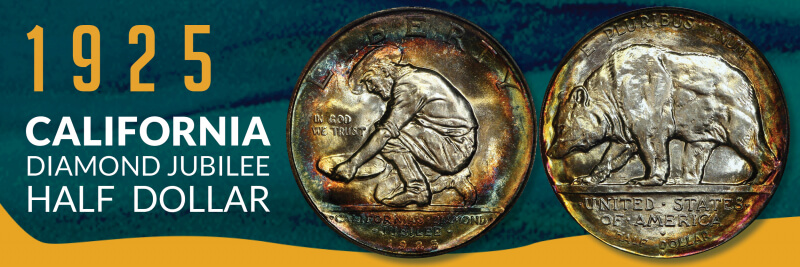
1925 California Diamond Jubilee Half Dollar
Click the images above for enhanced view.
Purpose:
To commemorate the 75th anniversary of California’s admission into the Union and fund the Diamond Jubilee celebration held in San Francisco.
Maximum Number Authorized: 300,000 pieces.
Sale Price: $1.00
Designs:
Obverse – Joseph Mora
A kneeling prospector facing left holding a miner’s pan. Below the miner and directly above the date appear the words “CALIFORNIA DIAMOND JUBILEE.”
Online Resource: https://www.pbs.org/wgbh/americanexperience/features/goldrush-california/
Reverse – Joseph Mora
A grizzly bear walking
Online Resource:
https://statesymbolsusa.org/symbol/california/state-mammal/grizzly-bear
Popularity:
Of the 300,000 pieces authorized to be minted, 150,000 were struck at the San Francisco Mint for the public. 63,606 unsold coins were returned to the Mint and melted.
Trivia:
-
494 California Diamond Jubilee half dollars were given to children in California who were born on September 9, 1925 (the official Diamond Jubilee date).
-
Indiana Congressman Albert Vestal, chairman of the House Committee on Coinage, Weights and Measures, was strongly opposed to legislation authorizing the coin.
-
A bill brought before President Coolidge authorized half dollars to be minted to celebrate the Diamond Jubilee in California, the 100th anniversary of the founding of Fort Vancouver in Washington and the sesquicentennial of the Battle of Bennington in Vermont. President Coolidge, who was born in Vermont, signed the bill into law.
-
The California Grizzly Bear became the official state animal of California in 1953. It had been extinct for over 30 years before the designation.
-
California achieved statehood as part of the Compromise of 1850. California was allowed to enter the Union as a free state. Utah and New Mexico could each decide to be slave or free territories based on popular sovereignty. The Fugitive Slave Law was strengthened across the country and no slave trade was allowed in the District of Columbia.
For more information:
Encyclopedia of the Commemorative Coins of the United States by Anthony J. Swiatek
KWS Publishers (2012)
Commemorative Coins of the United States Identification and Price Guide by Anthony J. Swiatek
Amos Press Publishers (2001)
References:
Encyclopedia of the Commemorative Coins of the United States by Anthony J. Swiatek
KWS Publishers (2012)
The Encyclopedia of United States Silver & Gold Commemorative Coins 1892 to 1954 by Anthony Swiatek and Walter Breen
Arco Publishing, Inc. (1981)

